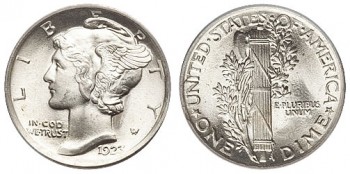Silver Mercury Dimes were introduced by the United States Mint in 1916 and were struck annually until 1945 (with the exception of three years). The silver coins are also known as Winged Liberty Head Dimes which is probably a more accurate title even if most coin enthusiasts do not routinely use it.
 The U.S. Mint struck each Mercury Dime from 90% silver with 0.0723 ounces of the precious metal. (Look to the right column to calculate coin melt values based on the latest price of silver.) The dimes have a total weight of 2.5 grams. As seen on the coin image, Liberty is showcased on the obverse while the reverse has Roman fasces in front of an olive branch.
The U.S. Mint struck each Mercury Dime from 90% silver with 0.0723 ounces of the precious metal. (Look to the right column to calculate coin melt values based on the latest price of silver.) The dimes have a total weight of 2.5 grams. As seen on the coin image, Liberty is showcased on the obverse while the reverse has Roman fasces in front of an olive branch.
Prior to the release of the 1916 dime, the U.S. Mint had been striking the Barber Dime for twenty five years. The older dime was named after its designer, United States Mint chief engraver Charles E. Barber. Barber had been allowed to redesign the dime in 1892 after Congressional legislation was introduced allowing coin designs to change after twenty-five years of use.
Historical Mercury Dime Silver Coin Melt Values
The design of the Barber Dime was not widely accepted by the public. When another twenty-five years had passed, many were eager to see it replaced. With the help of the United States Commission of Fine Arts (CFA), noted sculptor Adolph A. Weinman was selected along with two other artists to submit dime design proposals.
Weinman’s work was not only accepted for the new dime, but an additional Weinman design was also chosen to be used on the half dollar coin. Both proved extremely popular with the public and are considered to be among of the most beautiful coins ever produced by the U.S. Mint.
The obverse of the dime contains an image of a young mythical figure of Liberty complete with a Phrygian cap. The cap is adorned with wings meant to symbolize freedom of thought. However, many in the public misinterpreted the design and thought it was meant to represent the Roman god Mercury, thus resulting in the coin being known as a Mercury Dime.
Shown on the reverse of the dime is an image of a fasces (bundle of sticks with an ax blade emerging from them). Wrapping around the fasces is an olive branch. The design was meant to symbolize America’s interest in peace while still prepared for war.
Owing to its widely accepted designs, many coin enthusiasts collect Mercury Dimes which are relatively affordable and easy to obtain in lower grade levels. The key strike of the series is the 1916-D since just 264,000 pieces were struck.
Mercury Dimes with no real numismatic value are also sought after for their silver content owing to the 0.0723 ounces in each piece.
